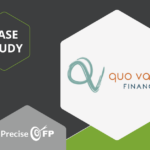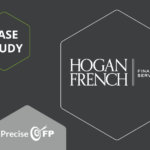Gone are the days when the life of a financial advisor could be envied. Remember the days being surrounded by stacks of papers on a cluttered desk? In today’s digital age, the financial advisor’s workspace is a web of Google Chrome tabs, each representing a different vital tool—CRM, financial planning software, data gathering software, calendar, email, custodians, and so much more. Each tool serves its unique purpose and is crucial for delivering top-notch customer service and achieving scalable success. Embracing automated, cloud-based solutions has become a necessity for wealth management firms, no longer a matter of if, but how much and when. To meet evolving customer expectations and efficiently handle vast data streams, RIAs must leverage cutting-edge tech that offers a holistic view of their business.
However, the journey of identifying and implementing the right tech integration is far from a walk in the park. It’s easier said than done. Selecting the wrong platform not only squanders resources but also diverts valuable employee time from essential tasks. In the worst scenarios, a misguided decision can even erode clients’ trust in your firm.
With little room for budgetary errors and the risk of lagging behind competitors, choosing the best tech solution becomes a critical endeavor. These key points must be considered when determining the optimal tech integration for your firm: learning curves, data migration processes, maintenance, training, business insights achievable, and integration capabilities. By thoughtfully evaluating these aspects, you can confidently navigate the tech landscape, providing your firm with a competitive edge, exceptional service, and sustainable growth.
Address the Right Operational Pain Points
No firm should purchase and implement a new technology without having a clear sense of who is responsible for (or owns) the solution at the firm and what it’s intended to solve for. Understanding the specific needs of your wealth management firm is key to weeding through the hundreds of available solutions to the single one that will work best for your needs.
Some good questions to ask yourself and your staff include:
- Is this technology a critical driver of my firm’s success?
- Does this technology have an internal champion or SME at my firm?
- Is this technology connected to other systems/platforms of the firm?
- Does the technology improve workflow and create efficiencies?
- Do you have any metrics to determine if you are getting value from the technology?
- Does the tech improve the client experience?
- Do all team members agree (buyer+users) on the value the tech provides?
- Do the people behind the technology (ie providers) understand our business?
- What operational pain points are you currently experiencing?
- Does the new technology significantly add to employees’ workload?
- What specific metrics will you use to determine whether the integration succeeds?
Technology should streamline existing processes and enable new ones. If your particular pain point involves the time back-office staff spend manually entering client data, look for solutions that automate the onboarding process. Similarly, if providing specific recommendations to clients is a goal, identify options that free up advisors’ time to focus on building relationships.
Most importantly, remember that any good tech integration should align with your overall business goals. Only once you’ve identified short- and long-term needs can you intelligently decide the type of integration that works best for you.
Make Sure Your Team Will Actually Use the New Tool
How your team members use the new technology is another important aspect to consider before committing to bringing it on board. For the most part, a well-integrated will fit seamlessly — or as seamlessly as possible — into the firm’s existing technology stack. Even better, the new platform should be intuitive and relatively easy to use. A dedicated support rep, extensive documentation and access to a help line can also assuage employee nervousness and ensure better adoption rates across the company.
Going into a big tech purchase, you have to assume different levels of familiarity with technical skills that may or may not be needed to use the new system. Adding complex dashboards, hit-or-miss system syncs and unlimited opportunities for customization invites unnecessary stress and frustration for team members.
Ensure Your Tech Stack Can Scale With You
Finally, the platform you select should be able to adapt as needed to shifts in the market or your business operations. Being scalable and flexible means the integration will help you grow revenue opportunities and attract new clients without causing undue hiccups.
Solutions offering open APIs and 360-degree customer views are typically best suited for change. Ensuring that customer data is secure and compliant is also a must-have in wealth management. Don’t be afraid to ask difficult questions on these topics to any provider you’re considering.
Your firm’s technology should save you time and money in the long term. Adjustment periods are expected, but consistent quality issues, employee complaints, and confusing infrastructures are not. Expect transparency, responsive customer service, and creative problem-solving from the integration option you select. Your firm’s success may rely on it.
For more information about how PreciseFP could integrate with your existing tech platforms, please visit our integrations page or connect with us in the chat.







